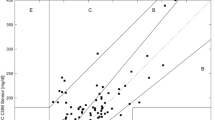Abstract
nzyme based biosensors suffer from loss of activity and sensitivity through a variety of processes. One major reason for the loss is through large molecular weight proteins settling onto the sensor and affecting sensor signal stability and disrupting enzyme function. One way to minimize loss of sensor activity is to filter out large molecular weight compounds before sensing small biochemicals such as glucose. A novel microdialysis microneedle is introduced that is capable of excluding large MW compounds based on size. Preliminary experimental evidence of membrane permeability is shown, as well as diffusion and permeability modeling. Microdialysis microneedles present an attractive first step towards decreasing size, patient discomfort and energy consumption of portable medical monitors over existing technologies.
Similar content being viewed by others
References
J. Brazzle, I. Papautsky, and A.B. Frazier, IEEE Engineering in Medicine and Biology Magazine, IEEE 18(6) 53–58 (1999).
T.A. Desai, W.H. Chu, J.K. Tu, G.M. Beattie, A. Hayek, and M. Ferrari, Biotechnology and Bioengineering 57(N1), 118–120 (1998).
T.A. Desai, D. Hansford, and M. Ferrari, Journal of Membrane Science 159(N1–2), 221–231 (1999).
S. Henry, D.V. McAllister, M. Allen, and M. Prausnitz, in Proceedings of the IEEE Eleventh Annual International Workshop on MEMS (Heidelberg, Germany, 1998), pp. 494–498.
M. Lambrechts and W. Sansen, Biosensors: Microelectrolchemical Devices (The Institute of Physics Publishing, New York, NY, 1992).
K. Lebouitz, “MEMS microshells for microneedles, microscale fluid visualization, and vacuum packaging of microdevices,” University of California at Berkeley, Ph.D. Thesis, 1998.
D. Liepmann, A. Pisano, and B. Sage, Diabetes Technology & Therapeutics 14, 469–476 (1999).
D. Liepmann, B.H. Sage, A.P. Pisano, and R.T. Howe, “Integrated μ FLUME Reconstitution System for Biological and Medical Supplies,” Abstract to DARPA, February 1997.
L. Lin, A.P. Pisano, and R.S. Muller, in Solid State Sensors and Actuator Conference, Transducers ‘93 (Japan, 1993), pp. 237–240.
E.M. Renkin, Journal of General Physiology 41, 225–243 (1954).
N. Talbot and A.P. Pisano, in Proceedings 1998 Solid State Sensor and Actuator Workshop (Hilton Head S.C., 1998), pp. 265–268.
B.C. Towe and V.B. Pizziconi, Biosensors and Bioelectronics (Elsevier) 12(9/10), 893–899 (1997).
J.D. Zahn, N.H. Talbot, D. Liepmann, and A.P. Pisano, Biomedical Microdevices 2(4), 295–303 (2000).
Author information
Authors and Affiliations
Corresponding author
Rights and permissions
About this article
Cite this article
Zahn, J.D., Trebotich, D. & Liepmann, D. Microdialysis Microneedles for Continuous Medical Monitoring. Biomed Microdevices 7, 59–69 (2005). https://doi.org/10.1007/s10544-005-6173-9
Issue Date:
DOI: https://doi.org/10.1007/s10544-005-6173-9




